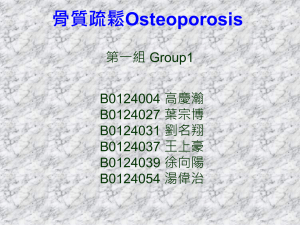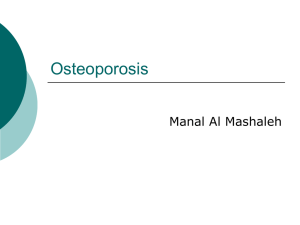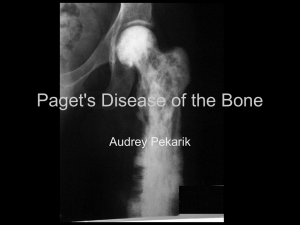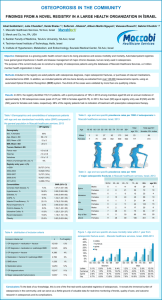Muscular-Skeletal - Porterville College
advertisement
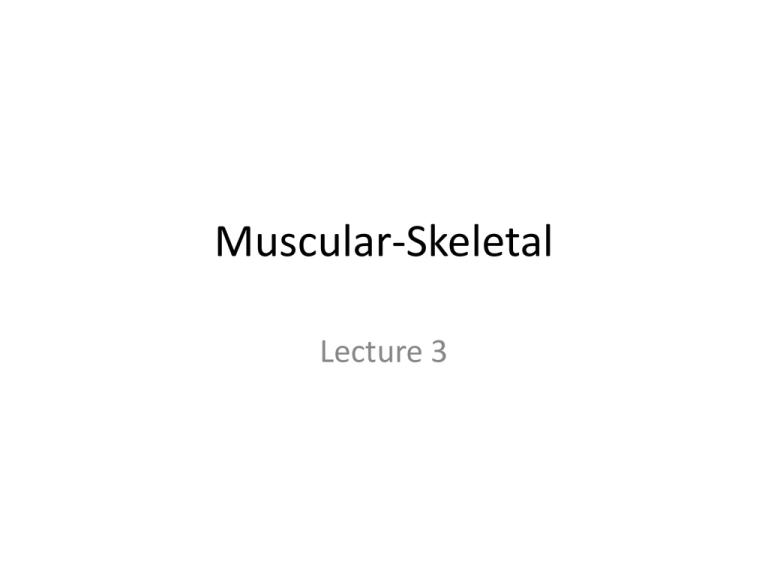
Muscular-Skeletal Lecture 3 Amputation • Pg 1080 Amputation • “removal of a body part, often an extremity” Amputation • Common Causes – Peripheral Vascular Disease (PVD) – Trauma – Osteomyelitis – Tumor • osteosarcoma Which of the following type of amputation is the most common? A. Upper extremity B. Lower extremity Amputation • Reason – Relieve symptoms – h function – h quality of life • Which of the following is the preferred type of amputation A. AKA B. BKA Amputation • Most distal point Amputation Nursing Assessment • Pre-op – Neurovascular status • CMS • Doppler • Ultrasound Amputation Nursing Assessment • Pre-op – Function – S&S of infection • C&S • Lymph nodes – Psych. status Amputation • Complications – Hemorrhage – Hematoma – Infection – Skin breakdown – Edema – Phantom limb pain – Contracture Table Question • What would you identify as the priority nursing diagnosis for a client who is postop BKA? Nrs Dx: for Amputation • • • • • • Acute pain Disturbed sensory perception Impaired skin integrity Grieving Self-care deficit Impaired physical mobility Acute Pain Nrs Dx: Acute Pain • • • • • Opioid Evacuation Δ position Sandbag Distraction Nrs Dx: Altered Sensory Perception • • • • h activity Rehab Distraction Rx – Analgesics – Tricyclic antidepressants – Anticonvulsants Nrs Dx: Impaired skin integrity • Gentle • Aseptic tech. • Diet – h protein – vitamins • Residual limb shaping – Elastic dressing – Cast Which of the following techniques is correct for obtaining a wound culture specimen from a surgical site? A. Thoroughly irrigate the wound before collecting the specimen. B. Use a sterile swab and wipe the crusty area around the outside of the wound. C. Gently roll a sterile swab from the center of the wound outward to collect drainage. D. Use a sterile swab to collect drainage from the dressing. NURSING ALERT • If the cast or elastic dressing comes off, the residual limb must be immediately wrap with an elastic compression bandage. If not, excessive edema will develop leading to a delay in rehabilitation. • Notify the surgeon so that another cast can be applied promptly Nrs Dx: Impaired body image Nrs Dx: Grieving • • • • • • Relationship of trust Pt. care for limb Independence Realistic goals Support systems Referrals Nrs Dx: Self Care Deficit • Practice • Nursing impact Nrs Dx: Impaired physical mobility • Prevent contractures • Avoid – Abduction – External rotation – Flexion • Prone* • ROM • Upper body exercises Nursing Alert • The residual limb should not be placed on a pillow because a flexion contracture of the hip may result. A client hospitalized with MRSA (methicillinresistant staph aureus) is placed on contact precautions. Which statement is true regarding precautions for infections spread by contact? A. The client should be placed in a room with negative pressure. B. Infection requires close contact; therefore, the door may remain open. C. Transmission is highly likely, so the client should wear a mask at all times. D. Infection requires skin-to-skin contact and is prevented by hand washing, gloves, and a gown. A client who is admitted with an above-theknee amputation tells the nurse that his foot hurts and itches. Which response by the nurse indicates understanding of phantom limb pain? A. "The pain will go away in a few days.“ B. "The pain is due to peripheral nervous system interruptions. I will get you some pain medication." C. "The pain is psychological because your foot is no longer there." D. “The pain and itching are due to the infection you had before the surgery." The primary reason for rapid continuous rewarming of the area affected by frostbite is to: A. Lessen the amount of cellular damage B. Prevent the formation of blisters C. Promote movement D. Prevent pain and discomfort You are assigned to care for a patient with a Below the Knee Amputation (BKA). Among the patient’s orders is one which states that the patient should be placed in the prone position twice daily. The nurse knows that the reason for this is: A. Changing the patient’s position will help to prevent skin breakdown B. To observe the stump for signs of infection C. To assist the patient in doing ROM (Range of Motion) exercises D. To stretch the flexor muscles and prevent flexion contractures Small Group Questions 1. Look at the list of complications associated with an amputation. Identify ways to assess for each complication and treatment. 2. Describe the assessment of a patient going into surgery for a non-traumatic BKA. What is the number one reason people go to their doctor? A. Respiratory infection B. Back pain C. Ear infection D. Head aches E. Complaint of symptoms assoc. with heart attacks What is the number TWO reason people go to their doctor? A. Complaints of arthritis in the hands B. Back pain C. Ear infection D. Head aches E. Complaint of symptoms assoc. with heart attacks Low Back Pain • Pg 1117 Low Back Pain • Multiple causes Spinal Column • Vertebrae • Intervertebral disk Intervertebral disks • Youth – Cartilage – nucleus pulposus • Age – Cartilage • Dense • △ Shape Term Cervical Thoracic Lumbar Sacrum Coccyx # vertebrae 7 12 5 5 (fused) 3 Body area Neck Chest Low back Pelvis Tailbone Abrv. C1 – C7 T1 – T12 L1 – L5 S1 – S5 Spinal Column • Facet joints • Ligaments • Muscles Spinal Curves • Shock Absorbers http://www.spineuniverse.com/anatomy/cervi cal-spine-anatomy-animation Disk degeneration • Most common areas – L4 – L5 – L5 – S1 Disk protrusion • AKA – Herniated nucleus pulposus – “Slipped disk” • pressure on the nerve • “Radiating” pain • “Sciatica” Low Back Pain S&S • Acute – < 3 months • Chronic – > 3 months Low Back Pain S&S • Muscle spasm • i Lumbar curve If a paravertebral muscle is in spasm, how would you describe the muscle tone? A. Atonic B. Flaccid C. Increased muscle tone D. Decreased muscle tone Low Back Pain Assessment • • • • Hx & PE Reflexes CSM Pain. Low Back Pain Medical Management • If no serious problem • No additional testing • for 4 weeks. Low Back Pain Medical Management • Self-limiting – 4 wks • With – Rx – Rest – Relaxation Medical Management: Rx • Analgesics – Acetaminophen – NSAIDs • Muscle Relaxants – Cyclobenzaprine (Flexeril) – S/E • Drowsiness Medical Management: Rx • Tri-cyclic Antidepressants – Amitriptyline (Elavil) Low Back Pain Medical Management • Rest • No – Twisting – Bending – Lifting – Reaching Low Back Pain Medical Management • Bed rest – 1-2 days • Δ position frequently • No sitting > 50 min. • Gradual Nonpharmacologic Interventions • Relaxation – Heat – Spinal manipulation Low Back Pain Nursing interventions • Assess pain –i analgesics • Mattress – Firm – No sag • Lumbar flexion Low Back Pain Nursing interventions • h activities gradually • Low stress exercise • 2 wks abd. & trunk exercises • Improve posture Good body mechanics: Standing • • • • • • • Short duration 1 foot on a stool ⌀ high hills ⌀ flexion Shift wt Stand on cushion ⌀ Lock knees Good body mechanics: Sitting • Short duration • Chair – Straight back – Arm rests • • • • Knees h than hips Back support i extension Alt. sitting / walking Good body mechanics: Lifting • NEVER BEND AT THE WAIST! • Bend knees • Squat • Hold item close Lift with your legs No-No’s! • Bending at the waist • lifting without bending knees • twisting and lifting • Slouching • Holding breath when lifting Carpal Tunnel Syndrome • Pg 1078 Carpal Tunnel Syndrome • “Entrapment neuropathy” • http://video.about.com/ergonomics/C arpal-Tunnel-Syndrome.htm Carpal Tunnel Syndrome Pathophysiology • Median nerve • Compressed Carpal Tunnel Syndrome Etiology • Men vs Women? – Women • Age? – 30-60 • Risk Factor – Repetitive movements Carpal Tunnel Syndrome: S&S • Pain – Night • Paresthesia • ? weakness Carpal Tunnel Syndrome Assessment & Dx • Tinel’s sign – Percussing over the median nerve • Tingling • Numbness • Pain – Test = + Carpal Tunnel Syndrome Tx • Corticosteroids • Wrist splint Carpal Tunnel Syndrome Surgery • • • • Open nerve release Endoscopic laser Local anesthetic Cut carpal ligament Small Group Questions 1. What medications are frequently prescribed to a clinic with acute low back pain? What are their actions 2. What are the 3-R’s of Low Back pain treatment? 3. Mr. Jones is suffering from acute back pain, what would you advice him to do? (What would your teaching plan include)? 4. Describe the pathophysiology of carpal tunnel syndrome. 5. Demonstrate how to perform the Tinel sign. Osteoporosis: • Pg. 1089 Osteoporosis: Pathophysiology Bone resorption osteoclasts Bone formation osteoblasts Osteoporosis: Pathophysiology Bone Resorption > Bone formation = i bone mass Osteoporosis: Pathophysiology / Hormones • Age related changes • i Calcitonin – Resorption •i – Formation •h Osteoporosis: Pathophysiology / Hormones • Age related changes • i Estrogen – Resorption • Inhibits Osteoporosis: Pathophysiology / Hormones • Age related changes • h PTH – Resorption •h – Formation •i Osteoporosis: Pathophysiology • • • • Porous Brittle Fragile Fx easily • http://www.youtube.co m/watch?v=rHyeZhcoZc Q Osteoporosis • > 10 million Am. Have osteoporosis • 33.6 million have osteopenia • Men vs Women – Men < Women Osteoporosis S&S Fractures may be the first clinical manifestation of osteoporosis Osteoporosis Most Common Fx • Compression – Thoracic spine – Lumbar spine • Hip • Colles – wrist Osteoporosis S&S • • • • Collapsed vertebra Asymptomatic Kyphosis i height • protruding abdomen • Pulm. insufficiency Osteoporosis Risk Factors • Age • Men vs Women – WOMEN • Small framed vs. large framed – Small framed • Caucasian vs. Asian – Asian Osteoporosis Risk Factors • Nutritional factors – Adequate Cal. – Calcium – Vit. D Osteoporosis Risk Factors Physical Activity stimulates bone formation & remodeling Osteoporosis Risk Factors • Immobility Osteoporosis Assessment • X-ray – Lumbar • Biconcave – Thoracic • Wedge shaped Osteoporosis Assessment • Bone densitometry – Detect bone mineral density (BMD) • http://www.youtube.com/watch? v=heTObdmOU8o Osteoporosis Medical management • PREVENTION!!!!!! • Diet – Calcium • h – Vitamin • D • Exercise – Weight bearing Osteoporosis Prevention • Lifestyle – Alcohol – Smoking – Carbonated drinks? – Caffeine Osteoporosis Medical Management • Rx – Calcium • 1,000 mg/day Osteoporosis Medical Management • Rx – Calcium • 1,000 mg/day – Vit. D • 600 IU/day – Vit. C • 2,000 mg/day Osteoporosis Medical Management: Rx • • • • Calcium Supplement Caltrate / Citracal Split dose S/E – Abd. distention – Constipation Osteoporosis Medical Management: Rx • Bisphosphonates • Action – i bone resorption – h bone density • Nrs implications – – – – – AM Water NPO (ā & ṗ) Hold Ca+ ⌀ lye down Osteoporosis Medical Management: Rx • Estrogen replacement Osteoporosis Medical Management: FX • Colles Fx • Distal Radius • D/T – Fall on open hand • Reduced • Active ROM Osteoporosis Medical Management: FX • Hip • ORIF Osteoporosis Medical Management: FX • Compression Fx of vertebrae • Conservative* • If acute pain – Vertebroplasty Osteoporosis Nrs Process • Acute Pain – D/T compression fx • Rest – – – – – Supine Side-lying △ position frequently Flex knees No twisting • h activity as pain i Osteoporosis Nrs Process • Risk for constipation • D/T – Immobility – Meds • Assess – Intake – BS – BM Osteoporosis Nrs Process • Risk for constipation • Fiber –h • Fluids –h • Rx – Stool softeners Paget’s Disease • Page 1093 Paget’s disease Pathophysiology • • • • • • Rapid Bone Turnover h # of osteoclasts h bone resorption F/B h osteoblast activity Bone replacement Paget’s disease Pathophysiology • Disorganized bone replacement • Vascular • Weak • Pathologic fractures • bowed legs – Misalignment – Pain Paget’s disease S&S • Insidious • Deformity – Skull – Pelvis – Femur/tibia • Pain • Warm • Fx Paget’s Disease Assessment & Dx • Serum Ca+ – Normal • X-ray • Bone scan • Bone biopsy Paget’s Disease Medical Management • Pain – Rx • NSAIDs • Gait – Assistive devices – Shoe lifts – PT • Wt. control Paget’s Disease Medical Management: Rx • Calcitonin • Action – i bone resorption – i osteoclasts • Route – Sub q – Nasal Paget’s Disease Medical Management: Rx • Bisphosphonates • Action – i bone turnover Paget’s Disease: Nrs Management • Teaching Osteomalacia • Page 1093 Osteomalacia • AKA – Adult Rickets • Deficit or impaired absorption of – Ca+ – Vit. D Osteomalacia S&S • Pain • Difficulty △ positions* • Weak* • Waddle* • Kyphosis • Pathologic fx Osteomalacia Medical Management • Rx – Calcium – Vit. D – Bisphosphonate – Calcitonin Small Group Questions 1. What is the pathophysiology of Osteoporosis? 2. What effect do the hormones calcitonin, estrogen and PTH have on bone remodeling? 3. What are Bisphosphonates? What advice would you give to a client with these? 4. What is a Colles’ fracture? What is a compression fx (of the vertebrae) 5. What is the pathophysiology of Paget’s Disease and Osteomalacia? 6. How are Paget’s Disease and Osteomalacia similar and how are they different? During a home visit, a client with AIDS tells the nurse that he has been exposed to measles. Which action by the nurse is most appropriate? A. Administer an antibiotic B. Contact the physician for an order for immune globulin C. Administer an antiviral D. Tell the client that he should remain in isolation for 2 weeks A client is discharged home with a prescription for Coumadin (sodium warfarin). The client should be instructed to: A. Have a Protime done monthly B. Eat more fruits and vegetables C. Drink more liquids D. Avoid crowds Following an amputation, the advantage to the client for an immediate prosthesis fitting is: A. Ability to ambulate sooner B. Less chance of phantom limb sensation C. Dressing changes are not necessary D. Less edema


